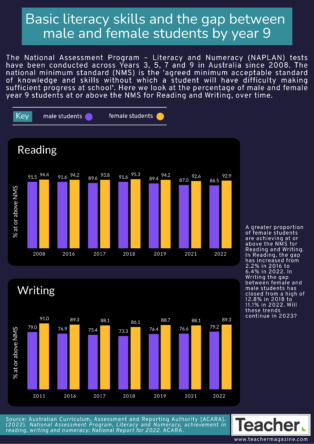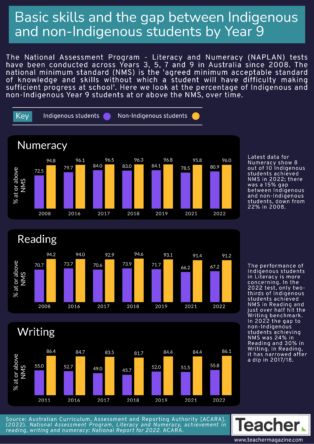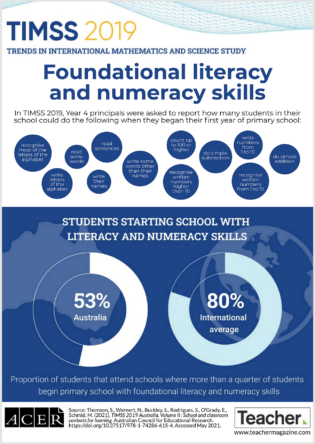As unlikely as it may seem, supervising diagnostic testing for incoming year 7 students is one of my most vivid memories as a teacher. One year, while most students were quietly completing the test, one student, Jack*, was crying uncontrollably. I would later realise that this was because Jack didn’t know how to read.
As a school teacher or leader, you will understand the challenge of addressing gaps in students’ literacy and numeracy skills. When students struggle in these areas, particularly at a foundational level, they can become disengaged and fall further behind their peers, making it difficult for them to catch up.
There are many potential approaches to supporting these students, making it hard to know where to start. The Australian Education Research Organisation’s (AERO) 'Implementing effective tiered interventions in secondary schools' project was launched to help schools address this issue.
What’s happening in Australian schools?
Together with the Australian Council of Education Research (ACER), we have recently published research that provides insight into what is currently happening in Australian schools and clarifies what effective support looks like. Our nationwide survey of secondary school staff – which you may have participated in via our promotions through Teacher magazine – found that while schools are trying to support these students, the approaches they adopt are inconsistent, and many teachers and leaders have big reservations about whether they are helping these students as effectively as they could be (Weldon et al., 2023).
What does the research say about developing student skills?
Our research review found that a variety of approaches for teaching foundational mathematics, writing and reading skills have been successfully applied at the secondary level (de Bruin et al., 2023). A clear finding is that explicit instruction is key to developing these foundational skills.
The report also showed that implementing multi-tiered frameworks – such as response to intervention (RTI) and, in particular, its successor, multi-tiered system of supports (MTSS) – enables schools to efficiently identify and effectively support struggling students.
Implementing tiered support – a school example
An MTSS model includes high-quality instruction for all students, regular testing to identify gaps in learning, and effective, evidence-backed interventions matched to the specific gaps in literacy and numeracy skills. Continuous, data-based tracking of student progress enables interventions to be adjusted to ensure students see learning gains.
Some Australian secondary schools are already implementing a tiered support framework. One is Como Secondary College in Western Australia. For the past 10 years, their Intensive Learning Team has been delivering targeted support for students who enter the school significantly behind their peers. This includes testing students on entry to understand their skill level in literacy and numeracy, diving deeper to identify specific gaps in skills, and then providing additional supports to those students in small group settings.
The additional classes are part of the school timetable in years 7, 8 and 9. Specialist teachers lead the classes and are supported by teaching assistants who can help provide additional one-on-one support where needed. They use direct instruction programs, developed to ensure that students can pick up skills quickly.
Importantly, the college is continually measuring student progress to ensure the interventions are working. Around a third of students take part in the support program and after 2 years, more than 75% are fully engaging in the at-level mainstream curriculum.
Guidance resources for educators
AERO has produced the first of a series of guidance resources on how schools can implement MTSS and adopt the broad and domain-specific instructional strategies that are most effective in supporting struggling students. Later this year, AERO will be producing further guidance to help schools implement MTSS effectively, covering the specifics of assessment and interventions for reading, as well as more operational decisions, such as the frequency of additional supports, size of tuition groups and staffing arrangements.
With the help of MTSS, our hope is that schools will be able to effectively support every Jack who enters their school gates, and that their confidence in finding a way forward is tangibly felt by the students who need that the most.
*name changed
References
de Bruin, K., Kestel, E., Francis, M., Forgasz, H., & Fries, R. (2023). Supporting students significantly behind in literacy and numeracy: a review of evidence-based approaches. edresearch.edu.au
Weldon, P. R., Heard, J., Thompson, J., & Stephenson, T. (2023). Implementing Effective Tiered Interventions in Secondary Schools: Survey of school and support staff. edresearch.edu.au
Thinking about your own school context:
How do you identify students who lack the foundational literacy and numeracy skills required to engage with the curriculum?
What framework do you and your colleagues use when deciding how best to support these students?
What supports and strategies do you use to help students catch up, and how do you monitor their effectiveness?



